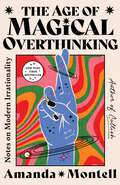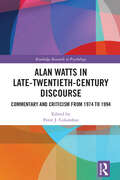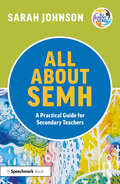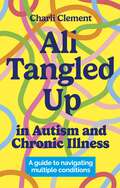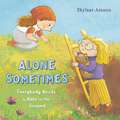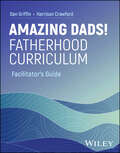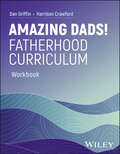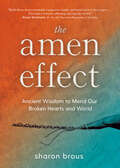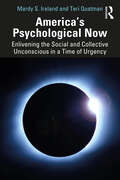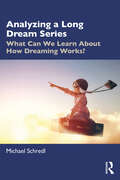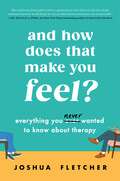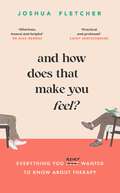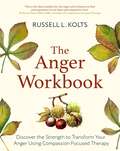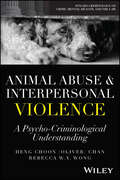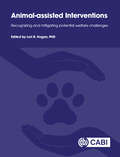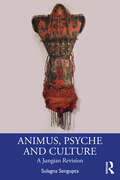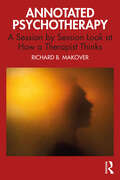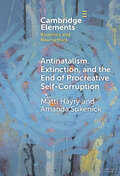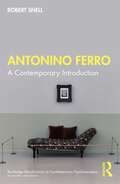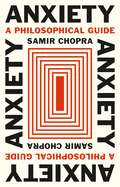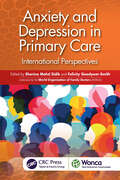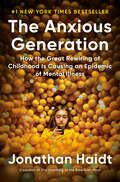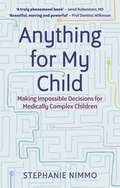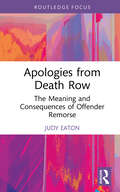- Table View
- List View
The Age of Magical Overthinking: Notes on Modern Irrationality
by Amanda MontellFrom the bestselling author of Cultish and host of the podcast Sounds Like a Cult, a delicious blend of cultural criticism and personal narrative that explores our cognitive biases and the power, disadvantages, and highlights of magical thinking. <P><P> Utilizing the linguistic insights of her “witty and brilliant” (Blyth Roberson, author of America the Beautiful?) first book Wordslut and the sociological explorations of her breakout hit Cultish, Amanda Montell now turns her erudite eye to the inner workings of the human mind and its biases in her most personal and electrifying work yet. <P><P> “Magical thinking” can be broadly defined as the belief that one’s internal thoughts can affect unrelated events in the external world: Think of the conviction that one can manifest their way out of poverty, stave off cancer with positive vibes, thwart the apocalypse by learning to can their own peaches, or transform an unhealthy relationship to a glorious one with loyalty alone. In all its forms, magical thinking works in service of restoring agency amid chaos, but in The Age of Magical Overthinking, Montell argues that in the modern information age, our brain’s coping mechanisms have been overloaded, and our irrationality turned up to an eleven. <P><P> In a series of razor sharp, deeply funny chapters, Montell delves into a cornucopia of the cognitive biases that run rampant in our brains, from how the “Halo effect” cultivates worship (and hatred) of larger than life celebrities, to how the “Sunk Cost Fallacy” can keep us in detrimental relationships long after we’ve realized they’re not serving us. As she illuminates these concepts with her signature brilliance and wit, Montell’s prevailing message is one of hope, empathy, and ultimately forgiveness for our anxiety-addled human selves. If you have all but lost faith in our ability to reason, Montell aims to make some sense of the senseless. To crack open a window in our minds, and let a warm breeze in. To help quiet the cacophony for a while, or even hear a melody in it. <p> <b>New York Times Bestseller</b>
Alan Watts in Late-Twentieth-Century Discourse: Commentary and Criticism from 1974-1994 (Routledge Research in Psychology)
by Peter J. ColumbusThis book is an anthology of commentary and criticism written within the transitional period between Alan Watts’ 1973 death and the twenty-first century intellectual horizon. Comprised of 16 chapters written and published between 1974 and 1994, with up-to-date introductions from the essayists and other contemporary thinkers, this volume opens a window onto unexplored grounds of Alan Watts’ impact within late-twentieth-century discourse – an intermediate space where scholars reoriented their bearings through changing times and emerging academic trends. Offering varied explanations and assessments of Alan Watts, including his influence on the Beat and Hippie generations, and his popularization of Zen Buddhism in America, it tackles unaddressed questions within the milieu of late-twentieth-century America from the Reagan Revolution and religious conservatism, to paradigm shifts in Buddhist studies and the rise of post-colonial theory. Contributors’ post-mortem analyses and critiques of Watts allow for a thematic rendering of their consonance or dissonance with noted Beat, Hippie, and Zen Buddhism themes of his lifetime. This volume will appeal to scholars and students of humanistic psychology, transpersonal psychology, the psychology of religion, comparative religion, and American studies.
All About SEMH: A Practical Guide for Secondary Teachers (All About SEND)
by Sarah JohnsonAll About SEMH is an accessible and informative guide for secondary school teachers, designed to increase their understanding of social, emotional and mental health needs, and to enhance their toolkit with practical, evidence-informed strategies to support learners in their care. The book unpicks key terminology and debunks myths and misconceptions, enabling teachers to more easily understand some of the challenges for learners with SEMH needs. It then explores a range of key areas including anxiety, depression, bereavement, obsessive-compulsive disorder and self-harm, and focuses on practical strategies and adaptations that can be made in every classroom. All About SEMH includes: A comprehensive introduction to social, emotional and mental health needs and the surrounding terms and policies. Practical strategies tailored to different conditions to help provide targeted support to secondary school learners. Case studies and worked examples to illustrate points in the book, supporting behaviour recognition and developing reader understanding. The difference between children’s behaviour at home and at school are examined, and the voices of parents of children with SEMH are woven throughout. Guidance on safeguarding and when to ask for additional support regarding concerns such as drug abuse or child exploitation. Easy to dip in and out of chapters with signposting to further research, resources and support. This accessible guide is a valuable resource to empower secondary educators, increasing their knowledge and understanding of SEMH, and providing a range of practical strategies to support every learner in their class. It will be essential reading for all secondary school educators, SENCOs and parents who are supporting children with SEMH needs.
All Tangled Up in Autism and Chronic Illness: A guide to navigating multiple conditions
by Charli ClementIn this ground-breaking debut, Charli Clement combines their own experiences alongside unique short profiles from individuals with chronic illness, to provide an intimate and insightful look at the complexities of living as an autistic and chronically ill person. From navigating your diagnosis and healthcare, learning how to manage pain and your own sensory needs to dealing with ableism, medical misogyny and transphobia, Clement offers practical advice and delves into the unique challenges faced by individuals living in this intersection.With a focus on the unique neurodivergent experience and an exploration into disability pride and joy 'All Tangled Up in Autism and Chronic Illness' is a necessary and empowering resource for autistic and chronically ill people as well as for family members, friends, and healthcare professionals.
Alone Sometimes: Everybody Needs a Hole in the Ground
by Skylaar AmannIn Skylaar Amann’s gentle, beautifully illustrated picture book, two best friends learn that sometimes everyone needs a quiet, safe space to just be. Ren and Kit are the best of friends, always doing everything together. But when Ren needs some quiet time to herself, she chooses to hide away in an unlikely place. Kit doesn’t understand, but she’s willing to listen and learn. And in the end, they both realize that sometimes, everybody needs a hole in the ground. Alone Sometimes speaks directly to the need we all occasionally have for a safe space where we can hide away from the frustrations of the world.
Amazing Dads! Fatherhood Curriculum, Facilitator's Guide
by Dan Griffin Harrison CrawfordThe only trauma-informed curriculum designed to turn men into great dads Amazing Dads Fatherhood Curriculum teaches fathers with kids of all ages to become exceptional parents. These detailed lessons meet dads where they are, starting from the common tendencies of male socialization to help explain key concepts of healthy fathering. Through a trauma-informed approach, this curriculum creates safety in the group setting while delving into critical topics that fathers simply do not tend to talk about with people in their lives. Unlike other fatherhood curricula, Amazing Dads addresses a breadth of topics, empowering men to discuss issues like family of origin, sexuality, how punishment can turn into abuse, self-care, and how toxic messages in the culture can hinder parent-child relationships. Each session incorporates grounding and breathing exercises, in addition to activities, exercises, and experiential opportunities that allow participants to connect with the material on a meaningful level. By the end of this course, fathers will have gained the increased self-awareness needed to enhance their relationships with their children and other family members. Lead fathers through a curriculum of targeted lessons focused on how male socialization affects their parenting Guide participants through exercises for developing relational, communication, and conflict resolution skills Connect with dads on a meaningful level by creating a safe space for discussions of trauma and other difficult subjects Explain important parenting concepts using examples, hands-on activities, and more This curriculum is excellent for use in parenting groups, behavioral health treatment programs, addiction treatment programs, and other community-based programs serving fathers. Dads of all backgrounds, with kids of all ages, will benefit from the wisdom in Amazing Dads Fatherhood Curriculum.
Amazing Dads! Fatherhood Curriculum, Workbook
by Dan Griffin Harrison CrawfordThe only trauma-informed curriculum designed to turn men into great dads Amazing Dads Fatherhood Curriculum teaches fathers with kids of all ages to become exceptional parents. These detailed lessons meet dads where they are, starting from the common tendencies of male socialization to help explain key concepts of healthy fathering. Through a trauma-informed approach, this curriculumcreates safety in the group setting while delving into critical topics that fathers simply do not tend to talk about with people in their lives. Unlike other fatherhood curricula, Amazing Dads addresses a breadth of topics, empowering men to discuss issues like family of origin, sexuality, how punishment can turn into abuse, self-care, and how toxic messages in the culture can hinder parent-child relationships. Each session incorporates grounding and breathing exercises, in addition to activities, exercises, and experiential opportunities that allow participants to connect with the material on a meaningful level. By the end of this course, fathers will have gained the increased self-awareness needed to enhance their relationships with their children and other family members. Lead fathers through a curriculum of targeted lessons focused on how male socialization affects their parenting Guide participants through exercises for developing relational, communication, and conflict resolution skills Connect with dads on a meaningful level by creating a safe space for discussions of trauma and other difficult subjects Explain important parenting concepts using examples, hands-on activities, and more This curriculum is excellent for use in parenting groups, behavioral health treatment programs, addiction treatment programs, and other community-based programs serving fathers. Dads of all backgrounds, with kids of all ages, will benefit from the wisdom in Amazing Dads Fatherhood Curriculum.
The Amen Effect: Ancient Wisdom to Mend Our Broken Hearts and World
by Sharon BrousThe national bestsellerFrom one of our country&’s most prominent rabbis, an inspiring book about the power of community based on one of her most impactful sermons.In a time of loneliness and isolation, social rupture and alienation, what will it take to mend our broken hearts and rebuild our society?Sharon Brous—a leading American rabbi—makes the case that the spiritual work of our time, as instinctual as it is counter-cultural, is to find our way to one other in celebration, in sorrow, and in solidarity. To show up for each other in moments of joy and pain, vulnerability and possibility, to invest in relationships of shared purpose and build communities of care. Brous contends that it is through honoring our most basic human instinct-- the yearning for real connection-- that we reawaken our shared humanity and begin to heal. This kind of sacred presence is captured by the word amen, a powerful ancient idea that we affirm the fullness of one another&’s experience by demonstrating, in body and word: &“I see you. You are not alone.&” An acclaimed preacher and story-teller, Brous pairs heart-driven anecdotes from her experience building and pastoring to a leading-edge faith community over the past two decades with ancient Jewish wisdom and contemporary science. The result is a clarion call: the sense of belonging engendered by our genuine presence is not only a social and biological need, but a moral and spiritual necessity.With original insights and practical tools, The Amen Effect translates foundational ideas into simple practices that connect us to our better angels, offering a blueprint for a more meaningful life and a more connected and caring world.
America’s Psychological Now: Enlivening the Social and Collective Unconscious in a Time of Urgency.
by Mardy Ireland Teri QuatmanThis book explores the causes behind Trump's victory in the 2016 US presidential election and asks how a psychoanalytic understanding of the social unconscious can help us plot a new direction for the future in US politics and beyond.It first describes the social/psychological threads that are the now of American culture. Seeds of hope are discovered through an in-depth examination of the American idea of excess as represented by Trump, its archetypal figure. Essential psychoanalytic ideas such as, the fundamental human condition of living with both individual and social unconscious, the psychic feminine principal, the notion of psychic valence and more are illustrated as psychic integrations necessary for America to move towards a redemptive positive social change. This book combines feminist exploration with playful illustrative imagery and mythic story—aiming to awaken minds across generations.America’s Psychological Now is key reading for psychoanalysis, psychologists, political theorists, and anyone wishing to understand better how the social and political systems could be changed for the future.
Analyzing a Long Dream Series: What Can We Learn About How Dreaming Works?
by Michael SchredlAnalyzing a Long Dream Series provides an extraordinary insight into the richness and variability of dreams, considering over 12,000 dreams that have been recorded for more than 30 years.Internationally recognized dream scientist Michael Schredl opens up his own personal dream series, offering a unique window into the interplay between waking life and dreaming. The book considers a huge range of dream topics, including family, friends, schoolmates, colleagues, erotic dreams, alongside the appearance of everyday objects. It also discusses rarer themes such as pain perception, temperature perception, and typical dreams about toilets, exams, and teeth. As the author is both the dreamer and the researcher, questions like why we dream about topics we have never experienced in waking life – for example, about the pain of being shot in the stomach – can be addressed, shedding light on the creative nature of dreams. The in-depth analyses provided in this book attempt to answer the field's most profound questions: why do we dream every night, and why do we dream in such creative ways about the issues that are important to us in waking life? The dreams analyzed question existing dream theories such as simulation theories, and the author proposes a function of recalled dreams for creative problem solving and provides ideas for future research.This fascinating book is an essential read for all dream researchers and students of the psychology of dreams.
And How Does That Make You Feel?: Everything You (N)ever Wanted to Know About Therapy
by Joshua FletcherPsychotherapist Josh Fletcher takes us on a tour of the inner mind of a therapist—revealing a hilariously candid point of view on the therapeutic process, a practical guide to therapy, and maybe a few more cobwebs and dark corners than one might expect. It’s everything you ever wanted to know about therapy (and maybe a few things you didn’t). Trauma, heartbreak, anxiety, and mourning are all parts of the human experience, and Josh Fletcher’s mission in life is to normalize the need to find a trusted professional with whom you can discuss all of life’s scariest aspects. Through the lens of four of his patients—Daphne, a wildly successful actor who still struggles to find contentment; Levi, an intimidating bouncer with obsessive tendencies who’s trapped in a sex cult; Zahra, an anxious, people-pleasing doctor in the midst of unpacking serious trauma; and Noah, a shy newcomer with some major closet skeletons—you’ll share in their self-discovery and recovery as they untangle themselves from an all-too-familiar web of emotions. In between sessions, Fletcher struggles to balance his own well-being with that of his patients as details from his sometimes messy but always heartfelt personal life reveal that therapists aren’t immune to getting tripped up by the same hurdles as the rest of us. And How Does That Make You Feel? is a primer on what to expect from therapy, how to find the right therapist, and the most common afflictions treated in therapy (such as depression, OCD, and panic attacks) as well as a darkly hilarious narrative about what’s going on in your therapist’s mind before, during, and after your session. Above all, it’s filled with the promise that a better future is always possible . . . if we’re willing to seek help and do the work.
And How Does That Make You Feel?: everything you (n)ever wanted to know about therapy
by Joshua FletcherExtraordinary. The psychology world has found its own Adam Kay. Dr Sophie Mort, clinical psychologist & Sunday Times bestselling author of A Manual for Being HumanHave you ever wondered what goes on behind the closed door of the therapist's office? What's revealed there may surprise you.Psychotherapist Josh Fletcher takes us on a candid and human journey into the individual sessions of four patients - Levi, Zahra, Noah and Daphne - sharing their self-discovery and recovery as they engage in therapy for the first time. And he lets us into the inner thoughts of a therapist, from shock and sympathy while in session, to how it feels to run into a former client on a messy night out. Interspersed with straight-talking advice on common issues such as anxiety, OCD and panic attacks, as well as a therapist's guide to how to find the right therapist, And How Does That Make You Feel? is darkly funny, illuminating and full of promise that a better future is always possible.It's everything you wanted to know about therapy (and quite a few things you probably didn't).Hilarious, honest and helpful. Dr Alex George, Sunday Times bestselling author of The Mind ManualRaw and honest. It will change the way you think about and treat your own mental health. Dr Nicole LePera, New York Times number one bestselling author of How to Do the WorkAn amazing and important book. Practical, profound, entertaining and enlightening. Cathy Rentzenbrink, Sunday Times bestselling author of The Last Act of Love
The Anger Workbook: Discover the Strength to Transform Your Anger Using Compassion Focused Therapy (Compassion Focused Therapy)
by Russell KoltsAnger is one of the most difficult emotions for human beings to cope with. If our anger is unmanaged, we can end up behaving in destructive ways towards both ourselves and other people, and can face relationship difficulties and negative health consequences. Far from 'letting ourselves off the hook', recent research has shown that by developing compassion towards ourselves and others and compassionately understanding our anger and the factors that fuel it, we can connect with the courage and skills needed to change our behaviour. This fascinating and practical self-help guide will give you a number of powerful techniques for tackling your anger head on and taking control of it, rather than letting it control you. USING THIS WORKBOOK, READERS WILL LEARN ABOUT: - The factors that trigger and fuel our anger, how it works and how to change the anger response - Specific skills to manage anger and improve relationships Filled with interactive exercises and practical skills, The Anger Workbook will guide you in your journey to transform your anger into inner strength. THE COMPASSIONATE MIND APPROACH The self-help books in this series are based on compassion focused therapy (CFT, developed by series editor Paul Gilbert). This brings together an understanding of how our mind can cause us difficulties but also provides us with a powerful solution in the shape of mindfulness and compassion. It teaches ways to stimulate the part of the brain connected with kindness, warmth, compassion and safeness, and to calm the part that makes us feel, anxious, angry, sad or depressed.
The Anger Workbook: Discover the Strength to Transform Your Anger Using Compassion Focused Therapy (Compassion Focused Therapy)
by Russell KoltsAnger is one of the most difficult emotions for human beings to cope with. If our anger is unmanaged, we can end up behaving in destructive ways towards both ourselves and other people, and can face relationship difficulties and negative health consequences. Far from 'letting ourselves off the hook', recent research has shown that by developing compassion towards ourselves and others and compassionately understanding our anger and the factors that fuel it, we can connect with the courage and skills needed to change our behaviour. This fascinating and practical self-help guide will give you a number of powerful techniques for tackling your anger head on and taking control of it, rather than letting it control you. USING THIS WORKBOOK, READERS WILL LEARN ABOUT: - The factors that trigger and fuel our anger, how it works and how to change the anger response - Specific skills to manage anger and improve relationships Filled with interactive exercises and practical skills, The Anger Workbook will guide you in your journey to transform your anger into inner strength. THE COMPASSIONATE MIND APPROACH The self-help books in this series are based on compassion focused therapy (CFT, developed by series editor Paul Gilbert). This brings together an understanding of how our mind can cause us difficulties but also provides us with a powerful solution in the shape of mindfulness and compassion. It teaches ways to stimulate the part of the brain connected with kindness, warmth, compassion and safeness, and to calm the part that makes us feel, anxious, angry, sad or depressed.
Animal Abuse and Interpersonal Violence: A Psycho-Criminological Understanding (Psycho-Criminology of Crime, Mental Health, and the Law)
by Heng Choon Oliver Chan Rebecca W. Y. WongANIMAL ABUSE & INTERPERSONAL VIOLENCE A COMPREHENSIVE EXAMINATION OF THE CAUSES OF, AND LINKS BETWEEN, INTERPERSONAL AND INTERSPECIES VIOLENCE Animal Abuse & Interpersonal Violence: A Psycho-Criminological Understanding addresses the many aspects of the link between animal cruelty and human violence. Presenting new theory, research, policy, and practice, this authoritative volume explores the subject through a psycho-criminological lens to describe, explain, and potentially prevent intentional behavior that causes pain, suffering, or death in animals and humans. With an integrated theoretical-practical approach, Animal Abuse & Interpersonal Violence offers up-to-date research and provides real-world insights into current thinking in the study of animal abuse and interpersonal violence. Sixteen in-depth chapters by a multidisciplinary team of active researchers and experienced field practitioners examine central topics in the field, including different forms of animal exploitation, connections between animal cruelty and substance abuse, the association between childhood animal cruelty and adult interpersonal violence, the role of veterinarians in the identification of animal abuse cases, the complex legal aspects of animal abuse cases, and more. Advances scholarship on animal abuse, its relationship with interpersonal violence, and the psycho-criminological mechanisms involved in that relationship Introduces readers to contemporary research on a range of topics and issues related to animal abuse and interpersonal violence Examines the origins of animal cruelty, its societal implications, and various prevention and treatment approaches Defines and describes various types of animal maltreatment and their links to different forms of interpersonal violence Animal Abuse & Interpersonal Violence: A Psycho-Criminological Understanding is essential reading for practitioners, researchers, scholars, and advanced students in fields such as behavioral science, law, criminology, veterinary forensics, criminal justice, law enforcement, social work, sociology, social sciences, education, and animal welfare.
Animal-assisted Interventions: Recognizing and Mitigating Potential Welfare Challenges
by Patti Anderson Nicky Barendrecht-Jenken Anna Van Berg Darlene Blackman Eileen Bona Donna Clarke Linda Chassman Craddock Yvonne Eaton-Stull Aubrey H. Fine Cynnie Foss Angela Fournier Megan French Nina Ekholm Fry Lisa-Maria Glenk Temple Grandin Susan D. Greenbaum Taylor Chastain Griffin Joy R. Hanson Terri Hlava Ann R. Howie Batya Gugenheim Jaffe Amy Johnson Suzanne M. Kapral Jean Kirnan Ursula A. Kohl Veronica Lac Elizabeth A. Letson Helen Lewis Kirsty MacQueen Arieahn Matamonasa-Bennett Angela M. Moe Julie Ann Nettifee Zenithson Ng Brittany Panus Caiti Peters Laura Poleshuck Missy Reed Elizabeth Ruegg Brenda Rynders Sarah Schlote Shira Smilovici Ashley Thompson Risë VanFleet Melissa Y. Winkle Katrina WinsorThis is a practical book exploring how to conduct animal assisted intervention (AAI) in ways that protect and prioritize animal and human welfare. This resource is for social scientists (e.g., psychology, social work, human development and family studies, etc.), as well as ethologists and animal behaviour and welfare students and practitioners. The book is a series of short chapters that depict a wide array of AAIs and their potential welfare concerns. The chapters include descriptions of the AAI offered, the welfare challenges, and ways to successfully mitigate these challenges. This book also covers critical topics including therapy animals' aging, retirement, and death as well as ethical issues including animal consent. Species include not only dogs, but horses, rabbits, and other small animals (e.g., guinea pigs, mice, etc.). Types of AAI involve individual interventions as well as crisis dogs (those who help after natural and man-made disasters), and residential animals. The book is designed to be a practical, engaging book with links to video and examples of real-life situations. It is evidence-based, yet user-friendly and directly applicable to students and practitioners. This highly practical and engaging book with examples of real life situations, videos and case studies, explores how to conduct animal assisted interventions in ways that protect and prioritize animal and human welfare. The book: · Explores how to conduct animal assisted intervention (AAI) in ways that protect and prioritize animal and human welfare. · Discusses potential welfare challenges including how to advocate for the animal, animal consent, and the animal's aging, retirement, or death. · Evidence based approach to mitigating welfare concerns for a wide range of therapy animals including dogs, horses, rabbits, rodents, and exotic animals - and their recipients. An invaluable resource for ethologists and animal behaviour and welfare students and practitioners, as well as social scientists (e.g., psychology, social work, human development and family studies).
Animus, Psyche and Culture: A Jungian Revision
by Sulagna SenguptaAnimus, Psyche and Culture takes Carl Jung’s concept of contra-sexual psyche and locates it within the cultural expanse of India, using ethnographic narratives, history, religion, myth, films, biographical extracts to deliberate on the feminine in psychological, social and archetypal realms. Jung’s concept of unconscious contra-sexuality, based on notions of feminine Eros and masculine Logos, was pioneering in his time, but took masculine and feminine to be fixed and essential attributes of gender in the psyche. This book explores the relevance of the animus, examining its rationale in current contexts of gender fluidity. Taking off from Post Jungian critiques, it proposes an exposition of the animus in history, social and religious phenomena, theories of knowledge, psychoid archetype and synchronicity, to grasp its nuances in diverse cultural worlds. This study re-envisions the notion of animus keeping in mind the intricacies of feminine subjectivity and the diversity of cultural worlds where depth psychological ideas are currently emerging. A remarkable reworking of Jungian ideas, this well-researched and important new book will be an insightful read for Jungian analysts and scholars with an interest in cultural and gender studies.
Annotated Psychotherapy: A Session by Session Look at How a Therapist Thinks
by Richard B. MakoverAnnotated Psychotherapy demonstrates how an experienced psychotherapist develops and carries out the right treatment plan through interactions with the patient or client. In these pages, clinicians will find an explanation of everything the therapist says to patients or clients: why they say it, what they intend it to do, how it fits in with the treatment plan for that person, and, importantly, what might have been said that would be better. Each of the eight sessions are presented in the form of a transcript that shows how a seasoned clinician might conduct the session—what their internal judgments are and what reasoning or rationale they might have for the therapeutic interventions they choose. Discussion sections after each transcript and a glossary provide helpful explanatory material for the key ideas and concepts, making this book an enlightening resource for therapists working and training in psychotherapy, whether their background is psychology, social work, psychiatry, or counseling.
Antinatalism, Extinction, and the End of Procreative Self-Corruption (Elements in Bioethics and Neuroethics)
by null Matti Häyry null Amanda SukenickThis Element provides an exploration of antinatalism, the view that assigns a negative value to reproduction. First, the history of Western philosophy as a two-and-a-half millennia reaction to antinatalist sentiments. Human life has no obvious meaning and philosophers have been forced to build elaborate theories to invent imaginary purposes. Second, analysis of the concept of antinatalism in the light of human extinction. If people stop having children, the species will cease to exist, and this prospect has prompted attempts to find alternatives and excuses. Third, outlines a normative view defending antinatalism both theoretically and practically. If it is wrong to bring about suffering in the absence of redeeming meaning and if it is possible to create meaning only by imposing a pronatalist mentality upon children before they can make up their own minds, parents morally corrupt themselves by procreating. This title is also available as Open Access on Cambridge Core.
Antonino Ferro: A Contemporary Introduction (Routledge Introductions to Contemporary Psychoanalysis)
by Robert SnellThis book provides a clear, thorough, and accessible introduction to the work of Antonino Ferro and draws on the clinical vignettes that punctuate his writings to show how Ferro has built on Bion’s revolutionary achievements to develop a distinctive, game-changing version of field theory in psychoanalysis.The book clarifies the phenomenological insight that the analyst and the patient together generate an ever-evolving, intersubjective field. Rather than the supposed psychology of the individual, it is this populous and multidimensional field, a co-created ‘in-between’ rich in characters and stories, that is to be explored and elaborated. The primary points of access to this new ‘multiverse’ are dream, reverie, metaphor, and imagination. A radical Negative Capability is called for, not least to help dissolve co-constructed ‘bastions’ obstructing the field’s expansion. The book sketches out the Italian and international context in which Ferro developed his thinking and addresses some key critical questions. It concludes that Ferro’s life’s work, which marries theoretical rigour with a revitalising increase in playfulness and freedom of response, is a transformational force within psychoanalysis and a major catalyst in its evolution.This important volume is rewarding reading for beginning and seasoned analysts alike, as well as for psychotherapists, counsellors, humanities scholars, and anyone interested in psychoanalysis.
Anxiety: A Philosophical Guide (Moral Psychology Of The Emotions Ser.)
by Samir ChopraHow philosophy can teach us to be less anxious about being anxious by understanding that it&’s an essential part of being humanToday, anxiety is usually thought of as a pathology, the most diagnosed and medicated of all psychological disorders. But anxiety isn&’t always or only a medical condition. Indeed, many philosophers argue that anxiety is a normal, even essential, part of being human, and that coming to terms with this fact is potentially transformative, allowing us to live more meaningful lives by giving us a richer understanding of ourselves. In Anxiety, Samir Chopra explores valuable insights about anxiety offered by ancient and modern philosophies—Buddhism, existentialism, psychoanalysis, and critical theory. Blending memoir and philosophy, he also tells how serious anxiety has affected his own life—and how philosophy has helped him cope with it.Chopra shows that many philosophers—including the Buddha, Kierkegaard, Nietzsche, Freud, and Heidegger—have viewed anxiety as an inevitable human response to existence: to be is to be anxious. Drawing on Karl Marx and Herbert Marcuse, Chopra examines how poverty and other material conditions can make anxiety worse, but he emphasizes that not even the rich can escape it. Nor can the medicated. Inseparable from the human condition, anxiety is indispensable for grasping it. Philosophy may not be able to cure anxiety but, by leading us to greater self-knowledge and self-acceptance, it may be able to make us less anxious about being anxious.Personal, poignant, and hopeful, Anxiety is a book for anyone who is curious about rethinking anxiety and learning why it might be a source not only of suffering but of insight.
Anxiety and Depression in Primary Care: International Perspectives (WONCA Family Medicine)
by Sherina Mohd Sidik Felicity Goodyear-SmithThis book provides practical information about depression and anxiety in primary care, with a focus on the approach in different countries and incorporating global ranges/prevalence, risk factors and health burden including that associated with COVID-19 and its pandemic. To ensure the challenges of a wide international primary care community are reflected fully, authors from different world regions – Africa, Asia Pacific, East Mediterranean, Europe, IberoAmericana-CIMF, North America and South Asia – have co-contributed to individual chapters on the detection and management of depression and anxiety in primary care in their own countries, including the screening tools used, how widely these tools are adopted and by whom, and current policies. As well as the medical model, it also presents the alternative viewpoint that feeling low or anxious is part of the human condition and the attention should be on supporting people in their journey through life, struggling to deal with the mainly social challenges they meet, rather than defining these problems as disorders or diseases requiring identification and treatment. Key Features: Explores the instruments used for the detection of depression and anxiety in primary care in various countries, and why and how these instruments are being used Describes the pharmaceutical and non-drug interventions for treating depression and anxiety in primary care and compares the similarities and differences in detecting and managing depression and anxiety in primary care among different countries Includes in-depth regional examples of how screening tools are used in practice and how policies can be established in the management of depression and anxiety in primary care Concludes with lessons learned from various countries and from different stakeholders with clear advice on what to do and, importantly, what not to do Addressing primary care detection and management of mental health issues across the globe, the book will be an invaluable practical aid for family medicine practitioners and the wider primary and community care teams and a useful reference for those involved in policy setting at regional and national levels including ministries of health.
The Anxious Generation: How the Great Rewiring of Childhood Is Causing an Epidemic of Mental Illness
by Jonathan HaidtFrom New York Times bestselling coauthor of The Coddling of the American Mind, an essential investigation into the collapse of youth mental health—and a plan for a healthier, freer childhood. <p><p> After more than a decade of stability or improvement, the mental health of adolescents plunged in the early 2010s. Rates of depression, anxiety, self-harm, and suicide rose sharply, more than doubling on many measures. Why? <p><p> In The Anxious Generation, social psychologist Jonathan Haidt lays out the facts about the epidemic of teen mental illness that hit many countries at the same time. He then investigates the nature of childhood, including why children need play and independent exploration to mature into competent, thriving adults. Haidt shows how the “play-based childhood” began to decline in the 1980s, and how it was finally wiped out by the arrival of the “phone-based childhood” in the early 2010s. He presents more than a dozen mechanisms by which this “great rewiring of childhood” has interfered with children’s social and neurological development, covering everything from sleep deprivation to attention fragmentation, addiction, loneliness, social contagion, social comparison, and perfectionism. He explains why social media damages girls more than boys and why boys have been withdrawing from the real world into the virtual world, with disastrous consequences for themselves, their families, and their societies. <p><p> Most important, Haidt issues a clear call to action. He diagnoses the “collective action problems” that trap us, and then proposes four simple rules that might set us free. He describes steps that parents, teachers, schools, tech companies, and governments can take to end the epidemic of mental illness and restore a more humane childhood. <p><p> Haidt has spent his career speaking truth backed by data in the most difficult landscapes—communities polarized by politics and religion, campuses battling culture wars, and now the public health emergency faced by Gen Z. We cannot afford to ignore his findings about protecting our children—and ourselves—from the psychological damage of a phone-based life. <p> <b>New York Times Bestseller</b>
Anything for My Child: Making Impossible Decisions for Medically Complex Children
by Stephanie NimmoEvery parent wants the same thing: for their child to enjoy a long and fulfilling life. But what happens when things don't go according to plan? What happens when parents have to become advocates for their child's healthcare needs? Who decides what is in a child's 'best interests'?Stephanie Nimmo faced these questions first-hand when her daughter, Daisy, was diagnosed with a life-limiting condition as a baby. Seen through the lens of Stephanie's own experiences, this sensitive book delves into the complex world of medical ethics and paediatric palliative care. From recognising tipping points to the importance of building relationships with palliative care teams well before crisis, this book explores how medical professionals can better support families throughout their child's care.Interviews with clinicians and snapshots from the lives of patients' families provide insight into the realities of life on both sides of the hospital bed. Compassionate explanations of the conflicting pressures in the hospital system foster understanding and help medical professionals and families work together.
Apologies from Death Row: The Meaning and Consequences of Offender Remorse (Routledge Studies in Criminal Behaviour)
by Judy EatonApologies from Death Row explores the notion of remorse, apologies, and forgiveness within the context of capital punishment in the United States, through the final words of offenders on death row, and the covictims’ responses to them in their statements to the press after witnessing the execution. The book demonstrates that there is evidence that some offenders on death row are truly remorseful and that some of the family members of their victims could benefit from this remorse, but that this is unlikely in the current system of capital punishment. Drawing from the fields of criminology, psychology, and sociology, the book begins with a theoretically informed introduction to the concepts of remorse and forgiveness, followed by an exploration of apology and forgiveness specifically in the context of capital punishment. It discusses how some initiatives within the criminal justice system, such as apology laws and restorative justice programmes, are being used to make it easier for offenders to apologize to their victims. Offenders on death row are considered, addressing why they might or might not apologize, and whether they are even capable of showing true remorse. The book then considers the family members of their victims ("covictims"), addressing whether they benefit from hearing the offender express remorse and witnessing the execution, and whether forgiveness is possible in this context. Evidence to support the arguments presented in the book come from the offenders’ final words and the covictims’ responses to them in their statements to the press. The book dispels two common myths about the death penalty. First, it shows that offenders on death row are not simply "monsters" who are incapable of understanding the severity of their crimes. Second, it provides evidence that, despite the popular belief that the death penalty is necessary in order to provide closure for the victims’ family members, it may actually have the opposite effect. The family members’ statements to the press after witnessing the execution contain more negative themes like anger and disappointment than positive themes like closure and peace. The book concludes with a discussion of the implications this has for systems of justice in general, and how a better understanding of the emotional state of offenders can help both victims and offenders. Apologies from Death Row will be of great interest to students and scholars of Criminology, Psychology, and Sociology.
